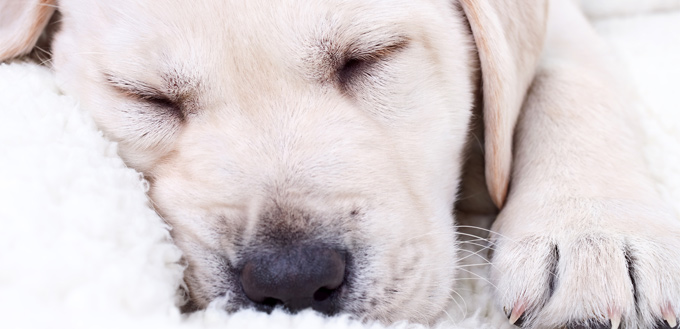You’ve probably heard a lot of people say that their dogs are very much like them, fully capable of ‘voicing’ out their concerns except that they do it in an entirely different way. While this may have some truth to it, we cannot escape the fact that the meanings we put into what we observe in our dogs are OUR own perceptions. They do not necessarily reflect what the dog really has in its mind. So, when you notice your dog crying or whining while asleep, it is perfectly okay to think that it is sad, perhaps dreaming, or perhaps overjoyed. This is us putting meaning into a dog’s behavior. What does it truly mean? Join us as we explore the many possibilities of this peculiar behavior in dogs.
Dog Communication
All animals communicate. It’s one of the essential characteristics of any living organism. The only hindrance, of course, is that they’re not gifted with the power of comprehensible speech (at least by human standards). Have you noticed your dog lowering its ears and tail every time you raise your voice? How about if you call its name as you walk into your house? Did you notice that gleeful smile on its face plus the frantic wag of its tail? They may bark, why not? But dogs communicate using body movements. Unfortunately, not all of us are also gifted with the ability to translate or decipher what these communication ‘cues’ really mean. We can only associate it with the circumstance and other overt cues from our dogs.

Dogs also make noises or sound to communicate. We know that they bark, yet we can also discern if their bark has a happier tone to it, a more anxious tone, or a really angry tone. They whine, too. They don’t sob and then wipe their tears with their paws. No, they don’t. When they whine, cry, or whimper it usually means they are telling us something. Regrettably, no one in the human kingdom can be very certain about what a ‘crying’ dog is telling us in pretty much the same way as a crying human doesn’t always denote sadness or grief. Some of us cry because we are overjoyed (have you seen a Miss Universe being crowned without getting teary-eyed on global TV?).
So, let us take a moment to look at the variables in the problem – crying dog while asleep. And since we always tend to associate any activity related to sleep with dreams, it is best to move forward with this in mind. There must be something in the dog’s dream that is making them whine or cry.
Do Dogs Even Dream?
You may not believe it, but dogs dream in the same way as we humans do. While we humans have 5 stages of sleep, however, dogs only have two. They call these the non-REM sleep (also known as slow-wave phase) and REM sleep, with REM meaning rapid eye movement.
As soon as dogs are sent to slumberland in one of the best dog beds, they immediately go into what we call the non-REM or slow-wave phase of sleep. If we are going to look at the electrical activity of the brain we will see very slow wave patterns, hence the name. During this phase of sleep, the body slowly whittles down many of its functions until only the vital organs are fully ‘awake’.
For example, the lungs will have to keep on expanding and partially collapsing to draw in oxygen-rich air and exhale carbon dioxide-rich air. The same is true with the heart. It continues pumping blood throughout the rest of the body. The brain, while we think that it is already sleeping, is still pretty much at work organizing and synchronizing these vital organs.
This stage of sleep will last about 10 to 20 minutes before going into the next phase which is the REM stage.
REM sleep is generally recognized as the body’s way of trying to repair itself, replenish lost nutrients and reserves, and prepare for another day. REM sleep is characterized by very fast brain wave patterns which indicate physical activity, although the dog is obviously in deep sleep. It is for this reason that dreaming is always associated with REM sleep.
In a dream state, the dog may be playing or interacting with another dog or maybe even its owner. Depending on the intensity of the ‘interaction’ in these dreams, the brain can be stimulated in such a way that it also sends electrical impulses to the different muscles of the body. That’s why we see muscle twitching, eye-darting movements, and yes, even noise such as crying, whimpering or whining.
From the moment your dog enters the slow-wave phase to the time the REM stage is completed, this will take about 30 to 45 minutes. The length of each sleep cycle is dependent on the dog’s age, size, breed, and even lifestyle.
If Dreams Trigger Dogs’ Crying While Asleep, What Do They Dream About?
This is where it can get really tricky. We can attach electrodes or probes into the skull of dogs to gain a picture of their brainwaves. But this doesn’t give us information as to the content of their dreams. All we see are peaks and troughs or ups and downs in these wave patterns. These are just irregular lines that only tell us the amount of electrical activity that the brain is going through within a given timeframe.
The difference between humans and dogs when it comes to dreams is that we can somehow communicate our vaguest recollections of the dream. Dogs, on the other hand, simply cannot utter a comprehensible sound that will tell us just what exactly they have dreamt about. As such, we can only offer our best guess.
It is highly possible that the dog is reenacting some or all of the activities or events that it may have experienced during the day.
For instance, if you notice your dog moving or even twitching its legs while sleeping it is possible that it is dreaming about running in the backyard or even in a wide-open field, chasing perhaps a rabbit, squirrel, or any other small prey. Now try to recall if it did such a thing during its waking hours of the day. There’s a good chance that it did.
The same is true with crying or whimpering. It is possible that it is trying to process that time you scolded your dog or maybe even when you left it alone in the house. Did you have it groomed by someone your dog dislikes? Think of any situation where you may have caused distress in your dog. There’s a good chance your dog is reliving these moments.
Again, these are just our best guesses.

A Dog’s Cry and What it is Trying to Communicate
Since a dog crying while sleeping essentially means it is trying to relive something that may have occurred or something that it truly needs, let us try to look at what it could possibly be communicating.
Pain or discomfort is one of the messages being conveyed whenever a dog is crying, whimpering, or whining. Dogs, as we said, don’t have the faculty to express in words their feelings and experiences. Your dog may have an injury that you are not completely aware of such as a brewing infection or inflammation in one part of its body that is not normally seen. It is also possible that there is already a tumor starting to encroach the surrounding tissues, causing pain as the mass compresses on nerve endings.
Another potential message that our dog’s cries are trying to convey is that it is being submissive. Being pack animals, dogs recognize the existence of an Alpha or a leader of the group. Whining is often a dog’s way of saying to the Alpha that it will follow its lead. This can also be seen in dogs that are confronted by more dominant canines. They always let out a faint whine as a sign of showing submission to the dominant dog.
Some dogs also whine when they see a person they love. It is a different kind of cry as it is equated more with joy, happiness, and excitement. This is often seen in combination with other dog behaviors such as spinning around or even jumping up and down. You should see these behaviors in your dog while it is sleeping.

There are also dogs that whine or cry whenever they want something. It is their way of getting attention or even getting something that they want. Unfortunately, this is learned behavior. If they are able to associate whining or crying with something that they can derive pleasure from, then they will keep on doing or repeating the same behavior. The thing is that this behavior (crying or whining) has worked before so it is worth doing it over and over.
It is important to realize that these ‘messages’ are a product of man’s interpretation of a variety of dog behavior.
While crying or whimpering is obviously a sign that your dog is dreaming, there are other cues that you may have to consider to help you decipher the doggie dream.
First, its breathing can be irregular. Ideally, a dog in deep slumber will have slow yet predictable breathing pattern. Sometimes, you may not even notice that it is breathing, except for the gentle rise and fall of its tummy. If you hear grunts or unusual movements in your dog’s chest or tummy, it is often an indication that it is dreaming. Again, this is in the absence of other signs or symptoms that may indicate pathology.
Second, you may notice the muscles in its face or even body to be jerking or twitching. This means the dog is already in the REM stage of its sleep. It is trying to ‘act’ the scene in its dream. Don’t worry, it doesn’t know that it is moving its legs or any other part of its body. It’s its brain that is stimulating these muscle groups to contract. You may even notice its whiskers to be somewhat twitching. Its limbs or paws can also tremble or quiver.
Third, try checking its closed eyelids (don’t force it open, though) and you’ll definitely see movement underneath. This is REM and it is one of the surest signs that your dog is already dreaming.

What You Should Do If Your Dog Cries While Sleeping
Watchdogs or not, all dogs are always alert about what is happening in their surroundings. They do this to protect their family or their pack from any harm. They can get easily aroused or awakened from their sleep. As such, they can easily wake up even before they have completed a sleep-wake cycle. It is for this reason that they need more sleep than we do.
When your dog cries while sleeping, let it be. Don’t try to wake it up since it is still in the middle of its dream. If you do, there’s a possibility that it may not recognize you immediately and snap at you or even bite you in the process. It is important to keep in mind that the REM stage of sleep is full of energy as depicted by its increased brainwave activity. Waking it up at this point can startle it and use this energy to snap at you.
Now, if your dog is making not whimpering noise but rather loud cries, it is possible that your dog is having a nightmare. You may try to wake it up, but you have to be cautious. Instead of shaking its body to arouse it from its sleep, it is better to call its name loud enough to jar it from its sleep. Alternatively, you can make loud noises so that it won’t bite you if it does wake up and get startled.
Dogs that cry while asleep are dogs that are dreaming. What they are dreaming is something that only they know, unfortunately.








Hi I have a very bueatiful but nervous 4 and a half yr old rescue staffy I am worried at times when she is napping she is crying twitching how do I no if its not possible she is having fits she is not like this at all when awake although very nervous with sounds